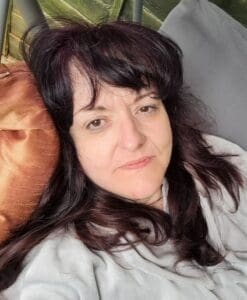The thing about mental health is you can’t see it when someone is struggling
Unless they look like this.
Then you might have a clue.

On Mental Health Awareness week this year I posted this selfie on LinkedIn in order to start a conversation. I figured it was time to be honest and talk about my other long term health condition; the one I waft away, or neglect to mention when I’m asked.
It seemed timely to share this photo at the end of an extended Bank Holiday weekend during which I spent each day crying and begging for the pain to stop.
At the time, my intention was not to make anyone uncomfortable.
I didn’t want readers to feel they should avert their gaze and I wasn’t asking anyone to do anything for me, or to check on me.
I was completely safe, lying on my garden swing.
The truth is I have a chronic pain condition which feels even more painful when my mood is low. Unfortunately, it’s a catch 22 situation as almost constant pain naturally lowers my mood, so I can’t really win.
Recently I pushed myself to travel to London for the wonderful, glitzy Disability Smart Awards ceremony. Being part of that incredible event brought a lump to my throat with happiness but for many days later this was my “payback world”.
Layered onto that reality was a heady mix of confused menopausal hormones – all of which aggravate my underlying chronic pain condition – giving me with quite a lot to process!
Mostly I keep it all in balance. My mental health and my physical disability. I call it a fragile equilibrium. Every day I apply my make up, get dressed for the (home) office and if I meet a client at 9am on Teams call, invariably by 11am my body pain has reduced. That happens almost daily. It can be such a relief to be busy and to keep my brain occupied with something other than pain signals!
I know the intrinsic sense of purpose I have in my work, as a Disability Business Partner at BDF, helps me; doing the job makes me smile and lifts my mood. And when I’m happier, or better still laughing, I feel far less pain in my body. So much less.
If I let the tears come – and sometimes they are unstoppable because I’m hurting too much, or I want to do something and I just can’t – then I get trapped by worsening pain because of my low mood.
My mental health challenges arrived before my disability. Although I was born with Ehlers Danlos Syndrome, it never really became disabling in the way it affected me until I reached my thirties.
However, I’ve had fluctuating anxiety and depression since 1997, when I experienced my first ever panic attack, and I’ve been on medication to treat it ever since.
Mostly my meds help but occasionally my crumbling body just becomes too painful for me to smile on through it all.
The day of my LinkedIn post was one of those extra painful days, so it was time to lie down and stay still, if only for a while. After more than a decade of living with chronic pain, I knew the intensity of the pain would eventually reduce after a few days of intentional rest, and then I’d be able to move more easily.
It’s a tricky balance for someone like me who wants to do so much living and make the world a better place, but has to wait for her body (and mind) to feel less pain in order to do exactly that!
Access our Mental Health Toolkit (Members and Partners only, with some resources open to all).